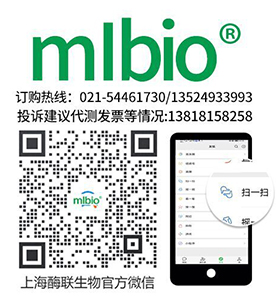产品货号 : mlR16642
英文名称 : Influenza A H1N1 Neuraminidase
中文名称 : A型H1N1流感病毒神经氨酸酶抗体
别 名 : Flu N1; Seasonal and Swine H1N1 Neuraminidase; Influenza N1; NRAM_I07A0; Seasonal Influenza A (H1N1) Neuraminidase.
研究领域 : 细菌及病毒
抗体来源 : Rabbit
克隆类型 : Polyclonal
交叉反应 : Influenza A virus
产品应用 : WB=1:500-2000 ELISA=1:500-1000 IHC-P=1:400-800 IHC-F=1:400-800 ICC=1:100-500 IF=1:100-500 (石蜡切片需做抗原修复)
not yet tested in other applications.
optimal dilutions/concentrations should be determined by the end user.
分 子 量 : 52kDa
性 状 : Lyophilized or Liquid
浓 度 : 1mg/ml
免 疫 原 : KLH conjugated synthetic peptide derived from Influenza A H1N1 Neuraminidase:201-300/470
亚 型 : IgG
纯化方法 : affinity purified by Protein A
储 存 液 : 0.01M TBS(pH7.4) with 1% BSA, 0.03% Proclin300 and 50% Glycerol.
保存条件 : Store at -20 °C for one year. Avoid repeated freeze/thaw cycles. The lyophilized antibody is stable at room temperature for at least one month and for greater than a year when kept at -20°C. When reconstituted in sterile pH 7.4 0.01M PBS or diluent of antibody the antibody is stable for at least two weeks at 2-4 °C.
PubMedPubMed
产品介绍background:
Influenza A virus is a major public health threat, killing more than 30,000 people per year in the USA. Influenza A virus has one of sixteen possible Hemagglutinin (HA) surface proteins and one of nine possible neuraminidase (NA) surface proteins. The Hemagglutinin protein facilitates viral attachment while neuraminidase is involved in viral release. These proteins also elicit immune responses that prevent infection or independently reduce viral replication.
Function:
Catalyzes the removal of terminal sialic acid residues from viral and cellular glycoconjugates. Cleaves off the terminal sialic acids on the glycosylated HA during virus budding to facilitate virus release. Additionally helps virus spread through the circulation by further removing sialic acids from the cell surface. These cleavages prevent self-aggregation and ensure the efficient spread of the progeny virus from cell to cell. Otherwise, infection would be limited to one round of replication. Described as a receptor-destroying enzyme because it cleaves a terminal sialic acid from the cellular receptors. May facilitate viral invasion of the upper airways by cleaving the sialic acid moieties on the mucin of the airway epithelial cells. Likely to plays a role in the budding process through its association with lipid rafts during intracellular transport. May additionally display a raft-association independent effect on budding. Plays a role in the determination of host range restriction on replication and virulence. Sialidase activity in late endosome/lysosome traffic seems to enhance virus replication (By similarity).
Subunit:
Homotetramer (By similarity).
Subcellular Location:
Virion membrane (By similarity). Host apical cell membrane; Single-pass type II membrane protein (By similarity). Note=Preferentially accumulates at the apical plasma membrane in infected polarized epithelial cells, which is the virus assembly site. Uses lipid rafts for cell surface transport and apical sorting. In the virion, forms a mushroom-shaped spike on the surface of the membrane (By similarity).
Post-translational modifications:
N-glycosylated (By similarity).
Similarity:
Belongs to the glycosyl hydrolase 34 family.
Important Note:
This product as supplied is intended for research use only, not for use in human, therapeutic or diagnostic applications.











